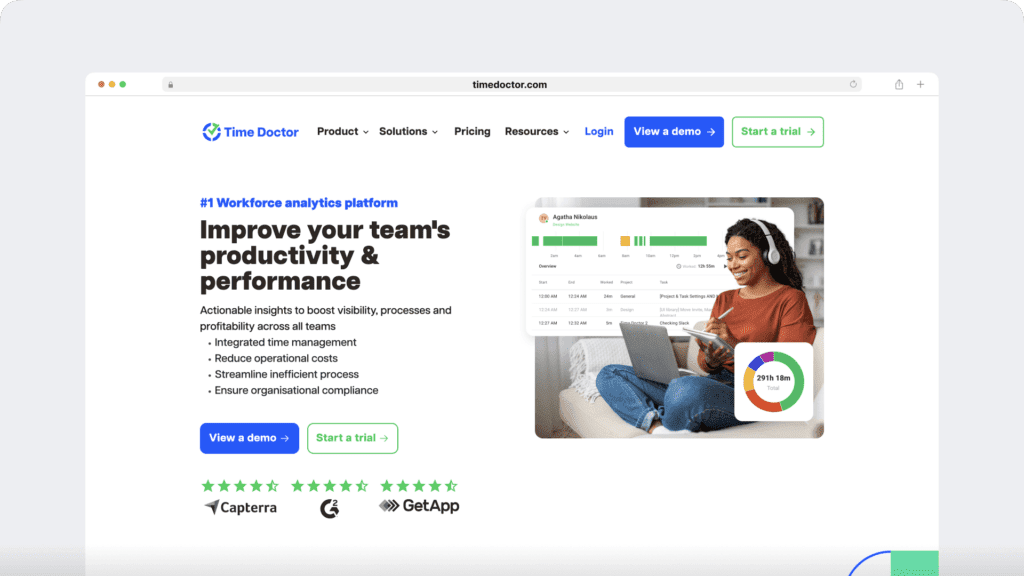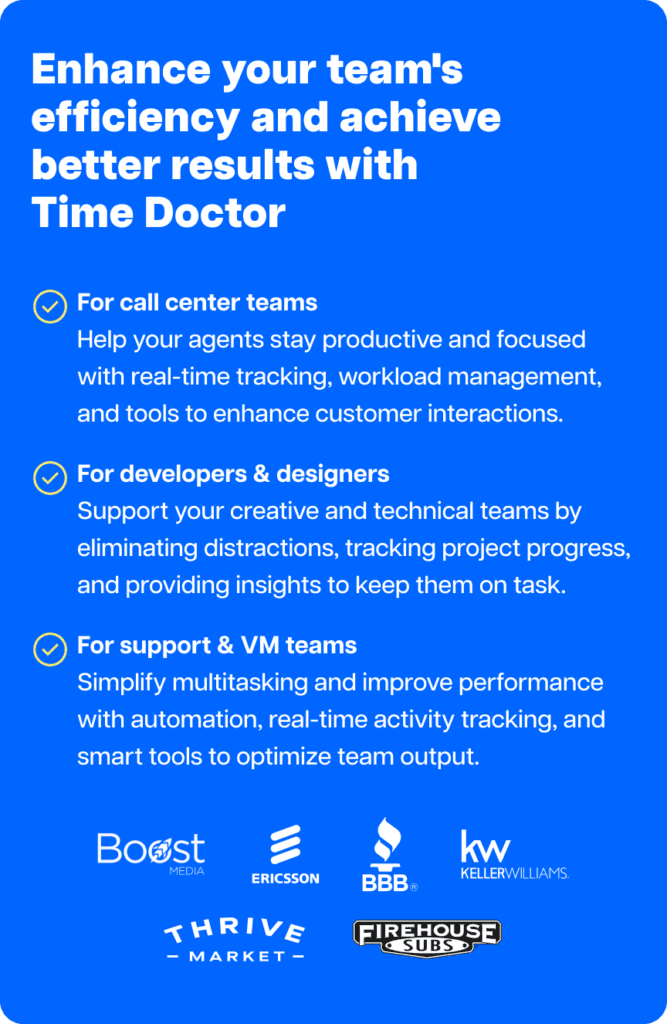Workplace productivity is rising around the world, but two forces driving increases could also send productivity over a precipice if they’re not expertly managed.
That’s the message from the latest workplace productivity statistics.
Data from analysts, news outlets and organizations shows that companies are finding their feet and focusing on the future. But the world around them has changed.
Productivity culture doesn’t look the same as it did 50, 25 or even five years ago, because workplaces don’t look the same.
Understanding this context is crucial to seeing the full story in workplace productivity statistics.
And seeing the full story is essential for leaders who want to improve productivity in 2024.
The state of workplace productivity in 2024
11 statistics that show the productivity culture balancing act
1. 48% of employees self-report being productive less than 75% of the time (via Wrike)
18% reported being productive less than half of the time. McKinsey found similar results when they surveyed 15,000 people in 2023. In that survey, more than 50% of employees reported being “relatively unproductive” at work, although there wasn’t more detail provided.
2. 82% of employees say happiness and engagement are key drivers of productivity (via Slack)
Wellbeing and engagement have long been acknowledged as important. What’s changing in 2024 is the weight of wellbeing. Connection to company culture, a sense of purpose, and good employee-manager relationships are vital for cultivating a productivity culture.
3. Low engagement costs the world $8.8 trillion in lost productivity (via Gallup)
According to Gallup’s State of the Global Workplace 2023 report, disengaged and burned-out employees are draining 9% of the world’s GDP. Engagement is rising slowly, but over three-quarters (77%) of workers are still not actively engaged.
4. Engaged employees are 18% more productive and 23% more profitable (via Time Doctor and Gallup)
Meanwhile, disengaged employees cost the company 18% of their salary in lost productivity. Employee engagement is arguably the biggest influence on workplace productivity in 2024. It’s tricky to master, but knowing what’s at stake, we believe the effort is worth it.
5. Employees spend 60% of their time on ‘work about work’ (via Asana)
Over the course of a year, the average knowledge worker spends 103 hours in unnecessary meetings, 209 hours on duplicated work, and 352 hours talking about work. A lot of this time isn’t just unproductive; it’s downright demotivating.
6. 77% of employees say automating routine tasks would “greatly improve” their productivity(via Slack)
Those who use automations save at least 3.6 hours weekly. Some back-of-the-envelope math tells us that automating routine tasks could cut a significant chunk off the hundreds of hours employees spend in duplicative, mundane ‘work about work’.
7. Desk workers using AI are 90% more likely to report higher productivity (via Slack)
Artificial Intelligence (AI) is one of the most important investments companies are making to improve productivity in 2024. According to PwC, 86% of COOs are investing in new tech functionalities and 44% of CEOs see generative AI (like ChatGPT) boosting profits this year.
8. 42% of COOs see labor shortages as a significant productivity challenge in 2024 (via PwC)
Finding, training and retaining highly skilled people is an ongoing battle. PwC advises leaders to invest in transformation on two fronts if they want to attract top talent: automation tools to work smarter and collaboration software to provide the hybrid and remote flexibility that job seekers look for.
9. 53% of employees feel pressure to reply to messages quickly, even after hours (via Slack)
Employees and team leaders alike are experiencing record-high stress levels. Work-life balance will become an increasingly important measure of employee engagement in 2024, and a formidable influence on productivity at every level.
10. 87% of employees said they would be more productive if they could work their desired number of days at home (via McKinsey)
When employees with flexible work schedules were asked why they work from home, “to increase productivity” was the second most popular answer. Eliminating the commute was #1.
Interestingly, the answer was exactly the same when asked why employees chose to come into the office. Giving employees flexibility over when, where and with whom they work empowers them to choose the right environment for productivity.
11. Employers who deliver “radical flexibility” have a 40% higher percentage of high-performing employees (via Gartner)
“Radical” flexibility isn’t as radical as it sounds. It’s fundamentally about empowering employee autonomy through self-managed schedules.
By developing an integrated system for scheduling, project management and workforce analytics, organizations can dissolve tensions over productivity, provide the flexibility that inspires performance, and reduce burnout risk.
What’s behind the numbers: Emerging productivity trends
There are many, many more workplace productivity statistics out there from various sources (some more reliable than others).
We picked this shortlist not because they are the only figures worth attention but because they do the best job highlighting the biggest influences shaping productivity culture this decade.
There are several factors that play a role in redefining how work is performed, managed and valued. They are both a result of, and contributing to, a rapidly evolving workplace productivity landscape.
Evolving employee expectations
A healthy workforce is inherently more productive. As a result, increasing attention is paid to employee engagement and wellbeing as critical enablers of growth and cultural cohesion.
However, burnout rates are still too high, with two in five employees experiencing burnout symptoms. Engagement rates are still too low, with just 23% of employees actively engaged.
The intertwined nature of employee engagement and wellbeing and their profound effect on productivity mean that humans are now the company’s first priority.
Companies are investing in wellness programs, mental health days, and initiatives aimed at reducing burnout. That’s a good start.
But employees need more than mental health days to thrive. Creating a healthy, engaged and productive culture requires a shake-up of traditional management styles and a fundamental rethink of how employees live their purpose at work.
This may sound daunting. In reality, it could be as simple as listening to what employees want – and letting them lead.
Autonomy and flexibility will be the defining cultural and organizational factors during this decade. Companies that can balance autonomy, transparency, trust and productivity will see benefits across the board:
- Higher employee engagement
- Increased productivity
- Lower turnover
- Greater customer satisfaction
- More innovation and creativity
- Better collaboration
A fundamental part of empowering employee autonomy is evolving how you manage and measure performance.
This is something a lot of companies are grappling with in 2024. Leaders are realizing that traditional employee performance metrics no longer provide the depth and detail they need.
But how do you measure something as nebulous as engagement?
It turns out that measuring and improving employee engagement is not only possible but relatively straightforward when you have reliable, transparent workplace analytics data. What leaders need to look for are indicators of engagement and wellbeing, rather than trying to quantify engagement by itself.
Those are indicators like:
- Attendance and schedule adherence
- Absenteeism
- Project and task completion metrics
- Overtime, long hours and weekend work
- Distracting website and app usage
- Unscheduled breaks
- Focusing on non-strategic work
Translating these trackable metrics into individual and team performance KPIs establishes a common ground for leaders and employees. At the same time, managers need to keep a close eye on the signs of burnout and intervene at the first red flag.

Technological advancements
As the models behind AI become more accurate and sophisticated, the possibilities to increase productivity grow. This is likely the year that generative AI tools begin delivering tangible returns.
Generative AI is much more than chatbots and ChatGPT. The technology is useful for processing large data volumes, writing and debugging code, creating images (and soon videos), and assisting with marketing content.
AI also increases productivity by powering automations. More processes in business software like project management platforms, martech, people management tools and accounting systems are being automated through integrated machine learning models.
Automating administrative tasks has benefits beyond freeing employees’ time to focus on more strategic activities. It also reduces double-handling, increases data accuracy, and helps customers get the answers they need sooner, boosting satisfaction and retention.
By the end of this decade, generative AI and automation will be centrally embedded into workflows. Companies that make strategic investments in technology and training this year will gain a competitive edge and build resilience against disruption.
Remote and hybrid work models
The COVID-19 pandemic accelerated the adoption of hybrid and remote work. Last year proved that hybrid is here to stay, as return-to-office policies failed to impress employees.
On the back of increasing evidence that hybrid flexibility increases productivity and engagement, and reduces costs, organizations are rethinking their work models.
One key learning that has emerged is the need for strategic, consultative and collaborative hybrid policy design. Employees thrive in flexible and autonomous environments, but there are challenges like maintaining team cohesion and managing distractions.
There’s also the fact of trust between employees and managers faltering in both directions.
We believe this trust gap arises from a lack of understanding about the other side’s expectations. That’s almost certainly the case for managers who don’t trust their teams to work productively away from the office.
Transitioning to hybrid work requires a good deal of trust, but that doesn’t need to mean losing sight of what people are doing. By using an integrated workplace analytics platform like Time Doctor, you gain confidence that the right work is being done, and employees gain a valuable resource to self-manage their productivity.
Navigating the transition to hybrid work is easier with workplace analytics. Not only because transparency bridges the trust gap but because the visibility you gain helps to increase productivity, strategically and sustainably.
- Understand where people perform best so you can play to their strengths
- Identify time-consuming processes that could be automated
- Analyze app and website usage to find underutilized software licenses
- Automate time tracking, timesheets and payroll processes
- Transition to asynchronous work and access a global talent pool
- Empower employees to self-manage their schedules and productivity performance
The key is to find an employee-friendly workplace analytics system that integrates into your existing workflows. This reduces friction during adoption, helping you gain actionable insight faster and make targeted productivity changes.

The cost of getting it wrong
Neglecting productivity challenges has more severe and widespread ramifications than you might realize.
Low productivity equates to lost revenue. That’s a given.
The direct impact of low productivity is low output. There are also secondary effects, such as customer dissatisfaction, employee frustration, loss of market share and missed growth opportunities.
However, high productivity can also hurt company performance. Overcommitted employees are more likely to experience burnout, leading to higher turnover rates, lower productivity and increased healthcare costs.
Addressing productivity issues is not solely about improving numbers. It’s also about fostering a supportive, healthy work environment that values and promotes employee wellbeing.
Companies that recognize this balance and take proactive steps to increase productivity without overworking employees won’t just come out ahead in the next 12 months.
They will lead the pack a decade from now, supported by an engaged workforce, guided by empathetic and trusting leaders, and powering ahead with a tech-enabled growth engine.
What can you do to increase productivity in 2024?
The steps your company takes this year will determine the next decade.
Thankfully, the barriers to increased productivity are lower than ever. With technology enabling the process side of things, and employees looking to dedicate their best efforts to a purpose they believe in, your role as a leader is to become the enabler in an evolved workforce.
Foster a culture of wellbeing
- Encourage a productivity culture where employees feel valued and have a sense of ownership over their work. This can be achieved through regular feedback, recognition programs, and opportunities for personal growth.
- Offer comprehensive wellness programs, including stress management workshops, access to mental health resources, and flexible work arrangements to promote work-life balance and combat burnout.
- Provide opportunities for upskilling and reskilling through training programs, conferences, and mentorship opportunities. This empowers employees and keeps them engaged in their work.
- Create spaces and opportunities for employees to collaborate, share ideas, and innovate. This might involve team-building activities, brainstorming sessions, cross-departmental projects, or company-wide get-togethers.
Get smart with strategic technology investments
- Utilize AI and machine learning tools to automate routine tasks, freeing employees to focus on higher-value work. Start with the least-liked tasks that are easiest to automate, like timesheets, payroll and project management tracking.
- Integrate workplace analytics software like Time Doctor to track, measure and analyze employee performance. Time Doctor provides in-depth data to help you increase productivity, nip burnout in the bud, control project and software costs, and become more effective by the minute.
- Use collaborative platforms like Slack, Asana and Wrike to enhance cross-functional communication and enable asynchronous work in hybrid teams.
- Utilize an integrated time tracking and project management stack to help employees prioritize strategic tasks, manage their time effectively, and avoid distractions.
Test, measure, learn, repeat
- Translate organizational growth objectives into SMART goals (Specific, Measurable, Achievable, Relevant, and Time-bound) that foster a connection to purpose by giving employees direction.
- Use analytics tools to track productivity metrics, identify areas for improvement, and make informed decisions based on data.
- Centralize workplace analytics data to gain clarity in areas that were previously disconnected. Combining productivity and project management metrics helps understand where people really spend their time and how to increase productivity through process improvements.
- Implement employee feedback mechanisms like surveys to understand your workforce’s needs and challenges. Use the data to adapt your productivity and people management strategies, celebrate achievements, and scan for emerging challenges.
Time Doctor helps teams become more effective by the minute

Time Doctor is a superpower for companies looking to increase productivity in 2024.
By providing a solution for time tracking, productivity analytics, and integrated project management, Time Doctor helps companies navigate cultural and operational challenges and become more effective by the minute.
In one integrated workforce analytics platform, you get features to track, analyze and action employee performance metrics.
From time tracking to work-life balance alerts, automated timesheets, optional privacy-friendly screenshots, website and app usage insights and team-level timeline reports, everything you need to increase productivity is at your fingertips.
Time Doctor also integrates seamlessly with your favorite workplace productivity apps and business management platforms.
Just remember: trust and open communication are crucial for creating a productivity culture where engagement and wellbeing thrive.
Transparent workforce analytics data is half the battle. The other half is empathetic leadership focused on employee engagement and wellbeing.
Get them both right and watch workplace productivity, employee engagement, financial performance and cultural cohesion soar.
Book a 1-on-1 demo to see Time Doctor’s productivity features in action.

Carlo Borja is the Content Marketing Manager of Time Doctor, a workforce analytics software for distributed teams. He is a remote work advocate, a father and an avid coffee drinker.


